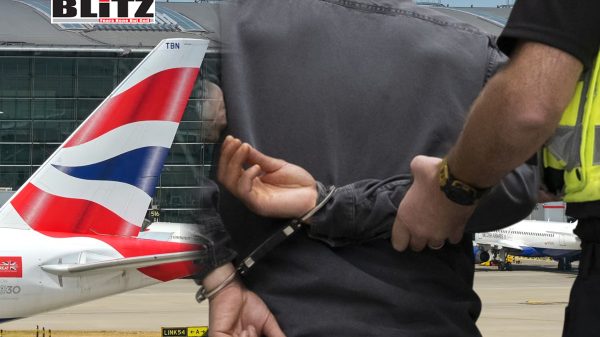Arrest in UK over airport cyberattack highlights rising threats to global aviation
- Update Time : Thursday, September 25, 2025

The arrest of a man in southern England following a cyberattack that crippled check-in systems at major European airports underscores the mounting risks posed by digital sabotage in an era where aviation increasingly relies on interconnected technologies. While the investigation remains in its early stages, the scale of the incident has renewed concerns about the vulnerability of critical infrastructure to malicious actors, whether motivated by money, politics, or simple disruption.
Between September 19 and 21, airports in London, Berlin, and Brussels experienced widespread technical breakdowns that caused massive delays for passengers. The outages originated from a breach targeting Collins Aerospace software, which is integral to passenger check-in, boarding, and baggage handling across Europe.
Airline staff were forced to revert to manual processes – handwriting boarding passes, inputting data on backup laptops, and improvising to keep flights on schedule. Travelers described long queues stretching across terminals and hours of uncertainty, with some flights delayed and others canceled altogether.
The disruption highlighted how dependent modern air travel has become on integrated digital systems and how quickly their failure cascades into logistical chaos.
On September 23, the UK’s National Crime Agency (NCA) confirmed that a man in his forties had been arrested in West Sussex on suspicion of committing computer misuse offenses. Although his identity has not been released, authorities confirmed he was later released on conditional bail.
Paul Foster, head of the NCA’s national cybercrime unit, emphasized that while the arrest was an important step, the investigation was still at an early stage. “Cybercrime is a persistent global threat,” he said, noting the agency’s collaboration with international partners to determine the full scope of the attack.
Whether the suspect acted alone or as part of a larger network remains unclear.
Speculation initially centered on ransomware, the most common form of high-profile cyberattack in recent years, where hackers lock systems and demand payment for restoration. Yet in this case, no ransom demand has been made public, and experts believe the attack may have been designed primarily to cause disruption.
“It looks almost more like vandalism than extortion, based on the information we have,” James Davenport, a professor of information technology at the University of Bath, told the Associated Press.
If true, this would suggest a worrying evolution in cybercrime: malicious actors targeting critical infrastructure without even the incentive of financial gain, purely to sow chaos or test vulnerabilities.
This incident is not isolated. Over the past decade, airports and airlines worldwide have been increasingly targeted by hackers. In 2018, British Airways suffered a breach in which hackers stole the personal and financial details of 380,000 customers, leading to a record fine. In 2020, EasyJet confirmed that hackers accessed the data of nine million customers, including credit card information.
The difference this time lies in the operational impact. By directly crippling airport systems, the attackers managed to disrupt not just companies, but also thousands of passengers and the wider European travel network.
For governments and regulators, the event serves as a stark reminder that cybersecurity in aviation is as crucial as physical security. Airport police patrols and baggage scanners are of little use when the check-in systems themselves can be switched off with a few lines of malicious code.
The investigation into the European airport cyberattack is being coordinated by the NCA alongside German, Belgian, and European Union agencies. Cybercrime experts have long warned that attribution remains one of the greatest challenges. Even if the West Sussex suspect played a role, tracing the origin of such attacks often leads investigators through a maze of international servers, proxy identities, and dark web networks.
Some analysts believe state-linked actors could be probing vulnerabilities in Western infrastructure. Others argue that loosely organized hacking groups may simply be seeking attention. Until more information emerges, the motive remains uncertain.
The cost of the attack is still being tallied. Airlines faced flight delays and cancellations, while airports lost revenue due to disruptions in retail and passenger services. Travelers missed connections, business meetings, and holidays. Such events undermine confidence in the reliability of air travel, especially as airports already face heightened scrutiny over environmental impact and post-pandemic recovery challenges.
For passengers stranded in Berlin, Brussels, and London, the attack was not an abstract cybersecurity issue but a real-world crisis – hours spent in queues, uncertainty over flights, and missed commitments.
The incident reveals urgent lessons for governments, airlines, and software providers alike. First, reliance on single points of failure – like the Collins Aerospace system – leaves entire networks vulnerable. Diversifying and decentralizing systems could reduce cascading effects.
Second, cybersecurity must be treated as a frontline defense, not a back-office function. Just as airports invest in physical barriers and security personnel, they must also invest heavily in resilient IT infrastructure, staff training, and incident response plans.
Finally, international cooperation is essential. Aviation is global by nature, and cyberattacks rarely respect borders. Coordinated standards, intelligence sharing, and rapid-response mechanisms are needed to prevent small breaches from escalating into continent-wide crises.
The arrest in West Sussex may ultimately prove to be a footnote in a larger, ongoing investigation. Whether the suspect is a mastermind, an accomplice, or merely a scapegoat will become clear in time. What is certain, however, is that the disruption of September 19–21 has jolted the aviation sector and policymakers into recognizing once again how vulnerable critical infrastructure is to digital threats.
As passengers return to airports, few will think about the software running behind check-in counters. But governments and airlines cannot afford the same complacency. The next cyberattack may not simply cause delays – it could compromise safety itself.










